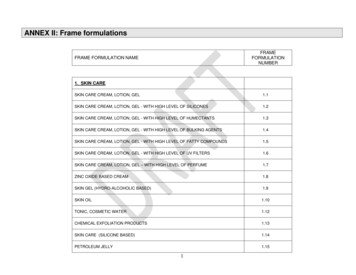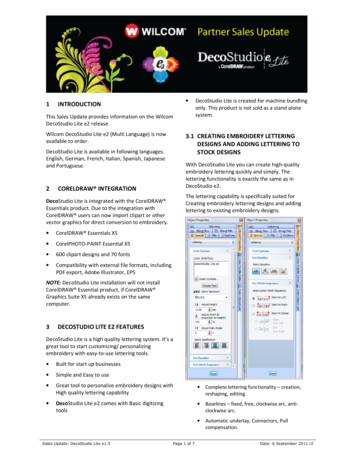
Transcription
ConceptualDesignForefront Identity ManagerKaren McLaughlinJanuary 29, 2013
Conceptual DesignForefront Identity ManagerOverviewThe purpose of this design is to provide information on the value – in addition to GlobalAddress List Synchronization (GAL Sync) – that a full implementation of Forefront IdentityManager (FIM) could bring to the Enterprise Active Directory (EAD). A conceptual design forGAL Sync was presented at the CTS Advisory Council at the December 2012 meeting. A requestfor more information on the other services that FIM can provide was requested at thatmeeting.FIM is the enabling technology for a more advanced identity management (IdM) strategy forthe Enterprise Active Directory. The goal of an identity management system is to manageindividual identifiers (accounts, attributes, groups, etc.), their authentication, authorization andprivileges within or across system and enterprise boundaries with the goal of increasing securityand productivity while decreasing cost, downtime and repetitive tasks. Much of the work thatis necessary to successfully implement a larger IdM strategy for the Enterprise would becompleted as part of a full FIM implementation. IdM for the Enterprise is being presented in aseparate document.A full implementation of FIM would bring the following business benefits to agencies that aremembers of the Enterprise Active Directory: Reduces administrative overhead for simple tasks such as password resets and groupmanagement Reduces costs and risk by automating identity management between identity sources. Enforces consistent use of attributes in the Active Directory by the use of polices,eliminating conflicts and functional issues when new applications are deployed (locallyor in the cloud) that use EAD for identity management. Decreases administrator workload by automating:o provisioning and deprovisioning of user accounts.o authorization and authentication to resources in the Active Directory and othersystems.o Many other administrative functions.January 29, 2013Page 1 of 11
Conceptual DesignForefront Identity Manager Provides a method for synchronizing account information and passwords betweendifferent systems, extending the ‘single signon’ experience.FIM Features and ServicesFIM Synchronization ServiceThis design is based upon use of Microsoft technology known as Forefront Identity Manager(FIM). The ’heart’ of any FIM implementation is the Synchronization Service. In its simplestimplementation, the FIM Synchronization Service is implemented in the EAD root and used tosynchronize object attributes from multiple identity stores and directories via LDAP.In a full implementation of FIM, it is used as a single point for account management for allconnected systems. FIM Management Agents are available for many directories and databasesystems to enable much of this synchronization ‘right out of the box’. In addition, a SoftwareDevelopment Kit (SDK) is available to allow for programing of any needed custom managementagents.Once FIM is implemented fully, management of user accounts, groups and other identityinformation is accomplished within the FIM system and synchronized to all the connectedsystems by FIM. This aggregation of information forms what Microsoft refers to as the FIM‘Metaverse’. Once this is in place, agency administrators do not have to manage multipleidentities across multiple systems for users, and users do not have to remember multipleaccounts and passwords across these systems.The synchronization service is also the key component for support of user self-service passwordreset, profile management, and group management.User and Administrative PortalThe FIM portal is the interface for managing identities in the FIM Service. The FIM portal isbased on SharePoint Web Services and allows end users and administrators to manage objectsin the FIM Metaverse including:January 29, 2013Page 2 of 11
Conceptual DesignForefront Identity Manager Self-Service Password ResetDistribution List and Group ManagementUser and Profile ManagementThe FIM Portal is fully customizable and the user and/or administrator will only see theappropriate options based on permissions assigned them within the portal. This allows for amore granular control over who can modify identity information across systems and morecomplete auditing of changes made through FIM. After FIM is implemented in the enterprise,all account and password management should be done through the Portal so that identities arepropagated correctly through all connected systems.Self Service Password Reset (SSPR)The FIM Self-Service password reset service allows users who have forgotten their password topass certain “gates” in order to reset their password without administrator intervention. Thepassword gates are established by Management Policy Rules (MPRs) and gating questions setby the administrator and other criteria and workflows. These can be customized for differentagency requirements or even for different groups of users (i.e. contractors vs. StateEmployees).Once an administrator grants permission, a user will be prompted to “register” for the selfservice password reset functionality. After completing registration and supplying gatingquestions, they will be able to use the password reset functionality. They can do that from theWindows login screen, Outlook Web App or the FIM User Portal.To further enhance SSPR, help desk staff can be delegated rights in the portal to reset ‘lockedout’ user accounts in order for the user to retry or change their passwords. If a user forgetstheir gating questions, administrators can be authorized to unlock their accounts and manuallyreset their password change ability through the portal.FIM can further enhance password management by password synchronization across allsystems with the Password Change Notification Service (PCNS) installed and running on theirJanuary 29, 2013Page 3 of 11
Conceptual DesignForefront Identity Managerdomain controllers. Note that this synchronization only occurs as part of the password changeevent; FIM is not a password repository.Group Management:By default, FIM is designed to manage Active Directory groups but can be extended to managegroup membership in other identity sources. FIM can manage Distribution Groups, SecurityGroups (Universal, Global and Domain Local) and mail-enabled groups with the same scope.There are three types of group management available in FIM: Manual: Many different scenarios exist for a manually managed group. A usercan request to be added to, or removed from, a group through the user portal.The group owner must approve or disapprove the addition or removal.Manager-based: Membership is based on reporting relationships to a manager.Criteria-Based: Dynamic membership in a group, based on filters and policies.All groups managed in FIM must have a group owner. This can be an individual or a serviceaccount. Workflows can be set up to automate these activities for a group. Groups can bemanaged by the owner through the FIM Portal or Outlook.FIM-managed groups do not equate to existing Active Directory groups by default. An initialway to bridge this gap is to create a new group in FIM and add the corresponding ActiveDirectory group as a member. Full definition of membership can be completed later.Management Policies and WorkflowsIf the synchronization Service is the ‘heart’ of FIM, the Management Policy Rules (MPRs) andworkflows are the ‘muscles’. Every action that happens in FIM is enabled by a MPR and/orworkflows. Policies work with the FIM synchronization service to define how account information is managedwho is authorized to access resourceshow attributes are populatedJanuary 29, 2013Page 4 of 11
Conceptual DesignForefront Identity Manager which system is authoritative for individual attribute informationwhat information can be input into attributesand many other tasks.For example, a simple workflow tied to a self-service password reset could be:o John Smith uses the self-service portal to request that his password be reset.o An automated email is sent to him with a Personal Identification Number (PIN)to be used to reset his password.o John is then able to submit the PIN along with answers to gating questions toreset his password.o An automated email is sent to John’s manager and the agency securitydepartment as an FYI in case John Smith’s account might be compromised.Another workflow for deprovisioning a user could look something like this: When the employee status attribute in the HRMS system becomes “inactive” theuser account is automatically disabled in Active DirectoryThe agency keycard database system, which has used the SDK to interface withFIM, automatically revokes the employee’s card access to the office building.An automated email is sent to their manager, the agency HR department,Information Technology System Administrator and Building SecurityAdministrator as an FYI of the actions taken.Additional actions can then be taken by the various departments as outlined ineither a manual or further automated workflow steps.FIM comes with hundreds of standard MPRs that can be used or customized and chained intoworkflows. Custom MPRs can also be created.January 29, 2013Page 5 of 11
Conceptual DesignForefront Identity ManagerDesignThis design covers a full implementation of FIM. It is inclusive of the implementation effort andcosts found in the previously created High Level Design for GAL Sync .Beyond the infrastructure required for the Synchronization Service, a full implementation ofFIM will also require: a FIM Service Server an additional SQL FIM Service database instance a FIM Portal Server.Both server functions can be implemented on virtual machines. The database instance can behoused on the same SQL Server that hosts the synchronization database.Provisioning just the Synchronization feature of FIM (as proposed for GAL Sync) does notrequire the purchase of client access licenses (CALs) from Microsoft to use. However, theadditional features required for a full FIM implementation will require the purchase of CALs forall users that use the more advanced features of FIM. These CALs are not currently included inthe State’s Enterprise Agreement and would need to be purchased by agencies or added to theEnterprise Agreement.Hardware and Software RequirementsThe FIM GAL Sync High Level Design (Synchronization Service only) specified the installation ofone physical IBM H23 Blade with Dual 8-Core Processors, 64 GB of RAM, (2) 300 GB hard drivesand 300 GB of Raid 1 SAN Storage. This configuration would also be sufficient to run the FIMSynchronization Service load under a full FIM implementation.The FIM Portal Server and FIM Service Servers do not have the processing requirements of thesynchronization service and can be deployed on virtual machines.In addition, a full FIM implementation will require an additional separate SQL instance. The FIMGAL Sync design was based upon using available capacity in our existing Exchange 2010 SQLenvironment, which has a 10 GB connection to the IBM Blade Chassis, and an unused node inJanuary 29, 2013Page 6 of 11
Conceptual DesignForefront Identity Managerthe four node cluster. This configuration should be also sufficient for the additional instanceand load anticipated for this service.High Availability and Disaster Recovery are accomplished in FIM by using a warm standby serverfor the FIM Synchronization and Service roles. FIM is installed on the standby with the servicesturned off. The Messaging SQL Cluster is already in a high-availability configuration, so nofurther work needs to be done for SQL. The Standby Server would be provisioned as a virtualmachine. If failover is necessary, a slight degradation in service would mean thatsynchronization times would increase until service could be restored to the physicalenvironment.A full test and pre-production environment needs to be created for the testing and verifying ofnew workflows and policies before they are implemented in the Production FIM System. Aprocess for approval and implementation of custom management agents, MPRs and workflowswill also need to be developed.Estimated Costs:Hardware and Software:Total Cost Estimate for Hardware, Software: 7,100 per month for the first year and 3,400 permonth thereafter.Production System:Hardware Costs: 2,800 per month(One Physical Server and 2 VMs)Percentage Cost for existing Messaging SQL Server Cluster: TBDSoftware Costs: 30,000 or 2,500.00 per month for 12 monthsPre-Production Environment:Hardware Costs: 600 per month (2 Virtual Servers [2 Cores, 4 GB RAM])Software Costs: 1,200Licenses:As discussed in the GAL Sync implementation, CALs are not required for the FIMsynchronization service. However, any of the additional features of FIM require a client accessJanuary 29, 2013Page 7 of 11
Conceptual DesignForefront Identity Managerlicense. The FIM client access license is currently listed as 11.37 per user on the selectagreement.FTEs:It is estimated that between 2.5 to 3.5 FTEs at the ITS5 and ITS6 level will be required foradministrative maintenance and workflow programming (see ‘CTS Support Responsibility’below for more detail).Vendor Costs:The implementation of GAL Sync, synchronization between Active Directory and FIM, and SSPRcould be implemented without consulting support.The implementation of synchronization between systems, workflow and MPR automation, andprovisioning and deprovisioning of users would require a consulting engagement, (such as withMCS) and would require resources to be committed from both CTS and EAD member agenciesfor the duration of the implementation.Total Costs:Here are the total ESTIMATED costs for CTS to deploy and support the infrastructure for FIM:ItemHardware and Software (Avg. over first 5 years)3 FTEs (1 ITS6, 1 ITS5, ITS4)Total Monthly Cost*Monthly Cost 4,140.00 42,395.00 46,535.00*Does not include the cost of client access licenses, which would be purchased by the agency(11.37 per FTE) or Project/Consulting Costs.If the decision is to recover these costs via an increase in the EAD rate, that would amount to 1.01 per user per month.Not estimated in this document are the FTE costs required for governance, standardizationeffort, and EAD join costs (for non-EAD members). These would be quantified and addressed ineach phase of the FIM roll-out (see Agency Implementation Responsibility).January 29, 2013Page 8 of 11
Conceptual DesignForefront Identity ManagerImplementation approach and level of effort:The full implementation of FIM would be a multi-phased project with escalating effort toimplement. Implementation by agencies could also be “staged” with agencies adoptingdifferent features as they are ready. Deployment of the infrastructure necessary to supportFIM will be a comparatively small effort – the main effort will come out of the larger IdMproject to develop, standardize, and implement processes and business practices into the FIMSystem.If GAL Sync is implemented first (as requested by the Legislative Service Center) thesynchronization service would be deployed as part of that effort. A project for fullimplementation of FIM could then proceed at its own pace with the addition of virtual webservers for the User and Management portal and the staged implementation of additional FIMServices.The following is a quick overview of the approach to a full implementation of FIM in the EAD byorder of effort and complexity: Implementation of the synchronization engine and connection to EAD.Implementation of GAL Sync for Legislative Service Center and other non-EADcustomers.Implementation of the User Portal for Self-Service Password ResetImplementation of Group Self-management for new groupsTransition of existing groups to the user portal for self-management.Implementation of synchronization of attributes between EAD and an externalauthoritative identity store such as Washington State’s Human Resources ManagementSystem (HRMS). This will require determination of the values and uses of attributes inthe EAD and mapping these attributes between identity stores, creation of workflows,and determination of key attributes used for synchronization.Automation of provisioning and deprovisioning of users, creating workflows, policiesand auditing.CTS Support Responsibility:CTS responsibilities would include support for the FIM Service, managing and monitoringsynchronization between systems, created management agents and implementing connectorsJanuary 29, 2013Page 9 of 11
Conceptual DesignForefront Identity Managerbetween FIM and other data stores, creating, implementing and managing all managementpolicy rules and workflows. Also required would be collaboration with the IdM GovernanceGroups and Agency Administrators on the creation of MPRs, Workflows, and ManagementAgents. This would be an ongoing requirement as EAD member agency business processeschange.Support costs cannot be broken out at this time by each individual FIM module, but would bedetermined through a more detailed design. However, for a full FIM implementation, it isestimated basic support would require: 2- 3 Full-time FIM administrators to monitor and manage FIM Services andSynchronization;A part-time Programming Resource for custom Management Agents, Filters,Management Policy Requests, Workflows, etc.Support levels will be determined, in part, on how much standardization can be agreed upon bythe governing groups. Support costs will increase based on the amount of requestedcustomization and the resulting complexity caused by customization of the FIM ServiceAgency Implementation Responsibility (reference the separate Identity Management – IdMdocument): Participate with other EAD agencies in an Identity Management Strategy for the EAD.Working with CTS, EAD Governance and internal business partners, determine businessprocesses that pertain to groups, password reset and other tasksDetermine agency systems that hold identity information that should be included in theagency IdM strategy.Work with CTS to determine authoritative sources for identity information.Make changes to their Active Directory structure, firewalls and attribute usage asrequired to implement FIM Services.Install software on desktops and servers as needed to enable FIM Services for users andadministrators.Train agency administrators on FIM Services so they are knowledgeable on the featuresand options that FIM can provide for Identity Management.Train users on different FIM Services as they are implemented and the use of the FIMPortal.January 29, 2013Page 10 of 11
Conceptual DesignForefront Identity ManagerAgency Support Responsibilities:As each of the modules of FIM is implemented, agency identity administration will graduallymove from existing management tools (ADUC, SQL, etc.) to the FIM administrative portal. Asmuch as possible, functionality in FIM will be delegated to agency administrators, as allowed byeach module of FIM.Agency administrators will be responsible for working with business partners within theiragency to identify processes that should be implemented into MPRs and workflows in FIM anddetermining which identity stores need to be connected to the FIM Synchronization Service.For MPRs and workflows that are not under their control, they will need to work with CTS FIMadministrative staff to develop and edit workflows based on new or evolving business practicesof the agency.SMEs for this Conceptual Design:Karen McLaughlin, CTS, CSD Design and PlanningBrian Casey, Microsoft, AD Dedicated Support EngineerResources:Implementing Forefront Identity Manger f793470January 29, 2013Page 11 of 11
GAL Sync design was based upon using available capacity in our existing Exchange 2010 SQL environment, which has a 10 GB connection to the IBM Blade Chassis, and an unused node in . Conceptual Design Forefront Identity Manager January 29, 2013 Page 7 of 11 the four node cluster. This configuration should be also sufficient for the additional .











